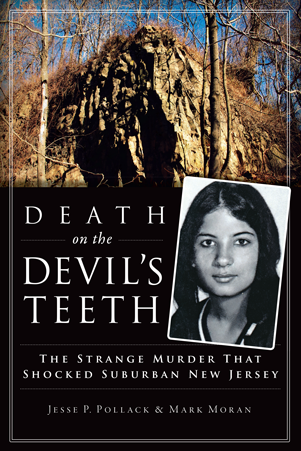
Re-investigating Death on the Devil’s Teeth
What do you do when a case goes cold? When you run out of witnesses, when the evidence offers no new answers, when all avenues of investigation have been exhausted, and when neither individuals nor artifacts offer any further nuggets or clues? Moreover, what do you do with a cold case from years ago and you’re coming in decades after the fact to reopen it?
For authors Jesse P. Pollack and Mark Moran, the answer is: keep digging. Proprietors and writers at the beloved magazine Weird NJ, Moran and his colleague Mark Sceurman had been unearthing strange and unsolved incidents in Garden State history for years. Whether it was the oft-repeated tale of the Jersey Devil, or more recent accounts of the unexplained and the paranormal, Moran and Sceurman (known as the Marks) had developed a connoisseur’s nose for the obscure.
Then the story of the 1972 murder of Jeannette DePalma came to their ears. DePalma, a young woman from Springfield, NJ, who had been missing from her family for some weeks, was found dead atop a hill overlooking the Houdaille Quarry, in what appeared to be a ritual slaying, possibly by occultists in the area. The positioning of her body along with artefacts nearby shocked the police officers who discovered her. While the case was never solved, it elicited a flurry of anger, terror, and suspicion within the small, Leave-It-To-Beaver kind of town, especially as other equally violent murders began to plague Springfield in the months to come.
These three diagrams illustrate the varying accounts of what was allegedly found near Jeannette DePalma’s body. These images were shown to several occult historians, all of whom agreed that no Satanic symbols or indicators of witchcraft were present.
For the Marks, such a story was impossible to resist, especially given how little had been written or publicly explored about it. Murder has no statute of limitations, and even decades later they felt that any attempt to bring DePalma’s killer to justice was warranted—but they quickly found that investigating this frozen-over case seemed to close just as many doors as it opened. Conflicting accounts of family and friends, the untimely deaths of key witnesses, secrecy of tight-knit communities (some with known connections to local organized crime), the unexplained obstructions of law enforcement, the refusal to release records even with FOI requests: how did Moran, Sceurman, and (later) Pollack do it?
If you’re going through hell, Winston Churchill famously once said, keep going. Which is how these investigators ultimately produced Death on the Devil’s Teeth: The Strange Murder That Shocked Suburban New Jersey. A master class in sleuthing, Moran and Pollack’s book acknowledge up front that there are simply some things we may never know about DePalma’s murder, including whether it was in fact a gruesome accident whose unidentified perpetrators staged in order to look like a murder, and thereby throw police off the case.
But their digging still turned up new leads, as members of the community came forward, and new names and clues came to light. To tie it all together, Moran and Pollack gave every competing account the time of day, presenting the evidence simply as they obtained it—whether it be testimony from the victim’s own sister or from local police as to teenage behavior at the time, accounts that at times stand in stark contrast to one another. Sifting through the community terror, recalcitrance, and misdirection about occultism in the area, the conversations they had with key witnesses appear in many cases as directly transcribed in their book, allowing the reader to form their own judgment, and decide on the most plausible theory of her death.

Cases go cold all the time. Sometimes, law enforcement is just too understaffed to give every case the attention it deserves, or turnover means that a given detective may find themselves reassigned or transferred altogether. Sometimes, investigators don’t even realize that incidents are linked: as recently as 2007, the discovery of a serial killer in south Louisiana was attributed to a local reporter who noticed curious similarities between dormant cases, as the documentary Bayou Blue describes.
Which is exactly where members of the public can help. Good memories, sharp observation, and a passion for justice: all these make up key attributes for investigators both official and unofficial. That, and a nose for the unexplained. Ask Sceurman and Moran, who had a unique way of saying farewell to anyone they meet in New Jersey:
“So long—let us know if you hear about anything weird!”







